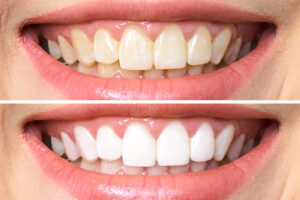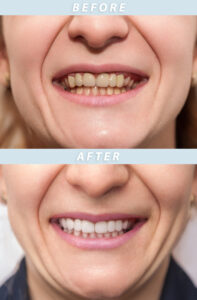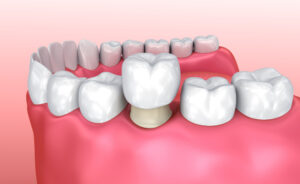Can I Whiten the Appearance of Old Crowns and Other Dental Work?
Absolutely!
On a technicality, that is . . . This question is worded in a way that allows us to say, without question, YES. We can whiten the appearance of crowns and other dental work. At Designer Smiles, we make beautiful smiles happen. There are very few limitations to what we can accomplish when we know your specific goals!
We’ll use the rest of the article to explain the details of why our answer is kind of a technicality.
How Does Teeth Whitening Work?
The important, and unfortunate, fact to understand here is that teeth whitening is just that: TEETH whitening. The active chemicals in teeth whitening (relatives of hydrogen peroxide) penetrate the enamel of teeth and break down darkly colored compounds under the surface. This actually changes the color of the tooth. This ability to seep into a tooth’s hard structures fuels the color change.
Teeth whitening only works on teeth.
In order to successfully whiten teeth, you must keep the whitening product in contact with the natural tooth surface for a minimum amount of time. This makes the method of application an important factor in the overall whitening result.
So Can You Whiten Old Crowns and Other Dental Work?
Unfortunately, the active whitening ingredients are powerless when facing a dental crown made of metal, porcelain, or a combination of the two. The peroxide chemicals cannot penetrate these materials. Even if the whitening material could penetrate through metal or porcelain, the change it would affect in the underlying tooth structure would not be visible through that material anyway. So the process would be futile when it comes to dental crowns.
In regards to tooth-colored dental fillings, some patients find a marginal level of success with teeth whitening. This is not because the filling material will change color. It will not. The success is related to the change in the color of the surrounding natural tooth structure. Depending on the size and position of the filling material, you can achieve some overall tooth whitening based on reflection of the whitened tooth structure into the relatively transparent filling.
In cases of veneers or other restorations that only cover a portion of the tooth, some patients and doctors like to try teeth whitening on any uncovered area of the teeth. For example, a patient who has thin porcelain veneers covering the front (lip-side) of the teeth can attempt whitening the back (tongue-side) to achieve some lightening of the underlying tooth structure, which might show through the transparent veneers.
Should I Try Whitening My Teeth, Even Though I Have Dental Work?
Sure!
Unless you have dental crowns covering all of your visible teeth, it’s worth a try. The natural teeth will whiten, and the tooth structure around any fillings or behind veneers will also lighten in color. You cannot hurt anything by using whitening products when you have dental work.
The important thing to understand is that you may begin to notice that your dental work appears darker. It isn’t getting darker, but the surrounding teeth are getting lighter, which makes crowns or fillings appear darker. If you whiten long enough, you may notice that your smile starts to look like Joseph’s Amazing Technicolor Dreamcoat: “of many colors”.
We advise our patients who want to whiten, even though they have dental work, to simply stop when they begin to notice this difference. Many are happy with the results and can just maintain the color of teeth at this point. Others want more whitening, so they will need to talk to Dr. Ann about the options for changing the appearance of crowns and other dental work.
How Can You Whiten the Appearance of Old Crowns and Other Dental Work?
 If you want your overall smile whiter than your current crowns or dental work appears, you’ll need to consider replacing those restorations. We have many patients who experience a scenario in which their dental work was a nice white color . . . a few decades ago. Now it appears flat or even dingy. This is because the colors we use for dental restorations now are far brighter and whiter than those used in the 1980’s and 90’s. A few decades ago, dentists created smiles using the whitest natural shade of teeth.
If you want your overall smile whiter than your current crowns or dental work appears, you’ll need to consider replacing those restorations. We have many patients who experience a scenario in which their dental work was a nice white color . . . a few decades ago. Now it appears flat or even dingy. This is because the colors we use for dental restorations now are far brighter and whiter than those used in the 1980’s and 90’s. A few decades ago, dentists created smiles using the whitest natural shade of teeth.
With the advent of teeth whitening, very few people are satisfied with a natural shade anymore. We all want the brightest smile possible. This means that what looked good 30 years ago doesn’t look so good today. Are you ready for an upgrade?
We can give you the color of teeth you desire regardless of the presence of dental work. The catch is that it usually involves replacing that dental work with newer, whiter materials.
What is the Process to Replace Dental Work?
 The process of replacing dental work, from the patient’s experience, is almost no different from the original dental work. Dr. Ann works to remove the existing crowns or fillings and clean away any underlying stains or decay. The use of local anesthetic is the same, and you have the option to request sedation if you want to experience less of it.
The process of replacing dental work, from the patient’s experience, is almost no different from the original dental work. Dr. Ann works to remove the existing crowns or fillings and clean away any underlying stains or decay. The use of local anesthetic is the same, and you have the option to request sedation if you want to experience less of it.
Replacing dental work is not risky or dangerous in any way. Dr. Ann’s ability to work with precision and her commitment to excellence enable her to remove the dental work and leave all healthy tooth structure. She conserves whatever is possible to reach your end goals.
Is It Expensive?
Replacing dental work costs the same as completing original dental work. A crown is a crown, and a filling is a filling. Depending on the age and state of your existing dental work, you can probably receive dental insurance benefits to cover a portion of the cost.
How Can I Get Started?
Call Designer Smiles to schedule a smile consultation with Dr. Ann. She can assess your current situation and make recommendations for various treatment options that will reach the goals you have for your smile.
